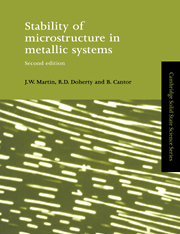Book contents
- Frontmatter
- Contents
- Preface to first edition
- Preface to second edition
- Chapter 1 The general problem of the stability of microstructure
- Chapter 2 Structural instability due to chemical free energy
- Chapter 3 Highly metastable alloys
- Chapter 4 Instability due to strain energy
- Chapter 5 Microstructural instability due to interfaces
- Chapter 6 Other causes of microstructural instability
- References
- Index
Chapter 2 - Structural instability due to chemical free energy
Published online by Cambridge University Press: 18 December 2009
- Frontmatter
- Contents
- Preface to first edition
- Preface to second edition
- Chapter 1 The general problem of the stability of microstructure
- Chapter 2 Structural instability due to chemical free energy
- Chapter 3 Highly metastable alloys
- Chapter 4 Instability due to strain energy
- Chapter 5 Microstructural instability due to interfaces
- Chapter 6 Other causes of microstructural instability
- References
- Index
Summary
Instability due to non-uniform solute distribution
The simplest instability in a metallic microstructure is that produced by a nonuniform distribution of solute in an otherwise stable single phase. Such a distribution always raises the free energy of the alloy and so it will decay to a uniform distribution at a rate determined by the thermodynamics and kinetics of diffusion. The kinetics of diffusion and its relationship to the concentration and mobility of point defects is one of the best-established topics in materials science, see, for example, Shewmon (1989), and so these topics need not be repeated here. However, the thermodynamics of diffusion is less widely discussed and is described below. Some new ideas on diffusion in alloys showing different rates of atomic motion in binary alloys as indicated by the Kirkendall effect are also described.
Thermodynamics of diffusion
Fig. 2.1 shows the free energy-composition diagram for a binary alloy. In stable regions of the system, where the second differential of the free energy with composition, ∂2G/∂C2, is less than zero, the free energy of composition C3, is increased from G3 to G′3 if it exists as a mixture of and rather than as a single uniform composition. The rise in G caused by any non-uniform solute distribution in stable regions of any phase provides the driving ‘force’ for the diffusion that homogenises the distribution.
- Type
- Chapter
- Information
- Stability of Microstructure in Metallic Systems , pp. 28 - 83Publisher: Cambridge University PressPrint publication year: 1997



